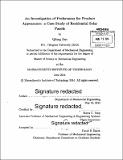| dc.contributor.advisor | Maria C. Yang. | en_US |
| dc.contributor.author | Bao, Qifang | en_US |
| dc.contributor.other | Massachusetts Institute of Technology. Department of Mechanical Engineering. | en_US |
| dc.date.accessioned | 2014-12-08T18:57:52Z | |
| dc.date.available | 2014-12-08T18:57:52Z | |
| dc.date.copyright | 2014 | en_US |
| dc.date.issued | 2014 | en_US |
| dc.identifier.uri | http://hdl.handle.net/1721.1/92227 | |
| dc.description | Thesis: S.M., Massachusetts Institute of Technology, Department of Mechanical Engineering, 2014. | en_US |
| dc.description | Cataloged from PDF version of thesis. | en_US |
| dc.description | Includes bibliographical references (pages 55-57). | en_US |
| dc.description.abstract | The importance of the styling and appearance of consumer products is widely understood. This paper evaluates the appearance of a technology-oriented product, the residential solar panel, using a quantitative approach known as visual conjoint analysis. The goal of this research was to determine the design attributes that make a solar panel more visually appealing, and to understand how different visual representations may reveal consumer preference differently. Approximately 200 survey respondents were shown two kinds of images of solar panels, one of a standalone panel and the other of a panel installed on a roof. The preferences for product appearance of solar panels were determined on two levels: one from an individual perspective and another from an aggregated point of view. By analyzing the preference on an individual level, the study further explores how presenting a solar panel in its context of use can influence the consistency of consumer preferences. The results show a significant shift of preferences when first showing the non-contextualized image and then showing the contextualized image. Such preference inconsistency provides insights with which to inform the process of user-needs revealing. By analyzing the preference on an aggregated level, attributes such as color, shape and pattern are determined to be more important than the frame style on influencing peoples preference for solar panel appearance. | en_US |
| dc.description.statementofresponsibility | by Qifang Bao. | en_US |
| dc.format.extent | 57 pages | en_US |
| dc.language.iso | eng | en_US |
| dc.publisher | Massachusetts Institute of Technology | en_US |
| dc.rights | M.I.T. theses are protected by copyright. They may be viewed from this source for any purpose, but reproduction or distribution in any format is prohibited without written permission. See provided URL for inquiries about permission. | en_US |
| dc.rights.uri | http://dspace.mit.edu/handle/1721.1/7582 | en_US |
| dc.subject | Mechanical Engineering. | en_US |
| dc.title | An investigation of preferences for product appearance : a case study of residential solar panels | en_US |
| dc.title.alternative | Case study of residential solar panels | en_US |
| dc.type | Thesis | en_US |
| dc.description.degree | S.M. | en_US |
| dc.contributor.department | Massachusetts Institute of Technology. Department of Mechanical Engineering | |
| dc.identifier.oclc | 897472071 | en_US |
